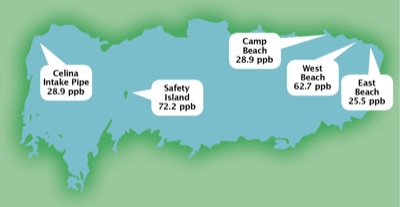Thursday, June 18th, 2009
Public can check algae toxin levels via Web page
By Nancy Allen

Photo by Daily Standard Staff
Parts per billion (ppb) concentrations of microcystin algae toxin in Grand Lake as measured on June 11. The World Health Organization recreational exposure limit is 20 ppb.
Users of Grand Lake now have a Web site to check on algae toxin levels in the lake.
The page was created by the Ohio EPA and is available at www.epa.state.oh.us/pic/glsm_algae.html. There are several links to the sampling data, fact sheets, news releases and other information, Ohio EPA spokeswoman Dina Pierce said.
The EPA will update the algae toxin levels as they receive new information, probably about every two weeks, she said.
The Ohio Department of Natural Resources (ODNR) and Celina Water Treatment Plant officials will collaborate to test the lake water for the algae toxin the rest of the recreation season and forward the information to Ohio EPA for posting on the Web site.
Right before Memorial Day weekend, the Ohio EPA, Department of Natural Resources and Department of Health issued a warning that levels of the toxin in the lake were high enough to warrant warnings about swimming, jet skiing and water skiing - activities that might result in ingesting water. Boating, fishing and sunbathing, activities unlikely to cause people to swallow the water, should still be safe, Pierce said.
The toxin can cause skin rashes, and if ingested, nausea, diarrhea and vomiting. It also can cause weakness or dizziness, breathing difficulty and convulsions, information from the Ohio EPA states. It is particularly deadly to small animals such as dogs, Pierce said.
Water testing continues to show algae toxin levels are still above the threshold for safety. The World Health Organization sets the recreational water exposure limit to the toxin at 20 parts per billion.
The most recent water samples taken a week ago ranged from 28.9 parts per billion to 72.2 parts per billion.
Readings from samples taken June 6 ranged from 55 to 73 parts per billion and samples taken on May 20 that resulted in the Memorial Day weekend warning ranged from 48 to 82 parts per billion.
Samples were taken from five locations: Grand Lake St. Marys State Park campground beach, the east beach, west beach, Safety Island and near the intake pipe for the city of Celina's water plant. Samples will continue to be taken from these five locations.
Celina's treated drinking water continues to test negative for the toxin, data shows. Grand Lake is Celina's sole source of drinking water.
Pierce noted that the toxin levels at the intake pipe, camp beach and east beach have dropped considerably, while the levels at Safety Island have gone up.
Pierce said the EPA is trying to learn more about the microystin toxin, saying this is the first time the EPA has dealt with it in Ohio. It is not totally understood why blue-green algae produces the toxin at certain times and not others, she said.
The state will continue to post the algae toxin levels so people can "make their own decision on using the lake," she said.
Most of the sediment and nutrients in the shallow, manmade lake come from runoff from farm land, the major land use in the ag intensive watershed, Ohio EPA water tests have shown. Excess nutrients feed the blue-green algae, which produces the toxin.




